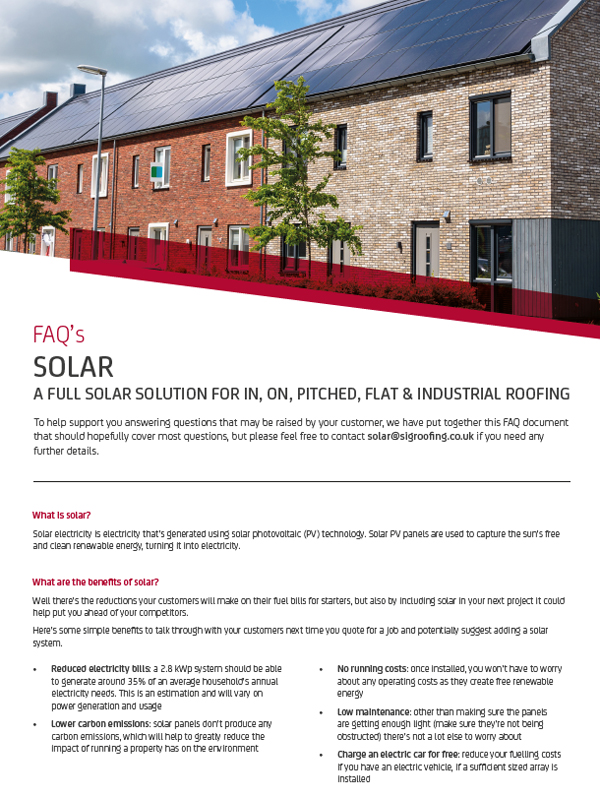Solar Module
Solar panels (or modules) are composed of individual interconnected solar cells, each of which is made from layers of silicon (wafers), treated with Boron, and Phosphorus to produce p or n type cells. The boron layer provides a positive charge, the phosphorus layer provides a negative charge, and the silicon wafer acts as a semiconductor when light hits the cell to energise the electrons.
Modules containing n type cells are usually slightly more efficient than their p type counterpart. The cells have metallic ‘bus bars’ that complete the circuit and allow the electrons to flow, conducting the direct current through the internal cell strings (cells connected in series) that feed to an electrical junction box on the rear of the module.
The cells are built up into a self-contained module, with a glass front, plastic back sheet, and aluminium outer frame. The modules are then interconnected with other adjacent modules in a series circuit using the positive & negative connectors at the back of the module from the junction box. These interconnected modules are then referred to as a string, which is wired back to the inverter. Multiple strings can be referred to as an array.
What happens when the sun shines?
When sunlight hits the top silicon layer, it ‘excites’ the electrons and gives them enough energy to move and as the electrons begin to flow from the top layer to the bottom, this results in a directional current (DC), which is then harnessed.
Main Types of Modules
Monocrystalline
These are made from a single pure silicon crystal ingot that is sliced thinly into many individual wafers. The special manufacturing process results in all the molecules of silicon arranged in the same crystalline structure creating one large crystal, hence Monocrystalline. Since they are made from pure silicon, they are identified by their dark black colour and are the most space efficient and longest lasting.
Polycrystalline
As the name implies, these come from different silicon crystals instead of one. The silicon fragments are melted and poured into a square mould meaning less wastage but a blue fragmented (less aesthetically appealing) appearance. They are less efficient in terms of energy conversion and space since their silicon purity and construction are lower than monocrystalline panels.
Did you know?
The plastic back sheets are typically white or black. Whilst the black back sheets are aesthetically pleasing, these can get a little warmer in summer and lose slight efficiency over an equivalent module with a white back sheet.
How much could you save?
The key question we all ask when it comes to Solar Panels. At SIG Roofing, whether you’re a homeowner, an installer or a roofer, we’ve made it simple for you to find out.
Using our unique mapping tool, get a personalised estimate, see the panels on the roof of your choice and importantly, see how long it takes for a solar setup to pay for itself.
Module Technology
Half-cell – The individual cells are cut in half and arranged in the module in distinct halves. The half cells on each side are still connected in series as normal, but then the two halves are connected in parallel with each other If one half is subject to shading the other isn’t affected. Due to the reduced cross-sectional area of the cell, there is lower internal resistance, therefore fewer electrical losses, and more power output.
PERC Passivated Emitter and Rear Cell (or Rear Contact) PERC technology is an improvement of a traditional cell that adds an extra layer in the rear surface of the cell that allows more sunlight to be captured and turned into electricity, making PERC cells more efficient than traditional cells typically an extra 5%.
This ‘passivation’ layer reflects light back into the cell and reduces the tendency of electrons to recombine and inhibit the flow of electrons in the system and allows greater wavelengths of light to be reflected preventing these longer wavelengths from becoming heat that would impair the cell’s performance.
Optimisers
Ensures modules individually maximise the optimum combination of current and voltage. We know that the product of current and voltage is Power so this optimum current & voltage combo on the IV curve is known as the maximum power point. Optimisers can be built into the module itself or can be physically added and mounted to the aluminium frame of the module, with each optimiser individually connected to its own module. They increase energy production by enabling each module to work independently giving more resilience to shading and also, enable module level monitoring. Shading or soiling causes a restriction of the current that can pass through a module. As the modules are connected in series strings, soiling has the effect of creating an ‘electrical bottleneck’, so the current is restricted through the other panels in the string as well, reducing the overall system output.
Power Rating
Smaller rated modules largely consist of fewer PV cells within the module, with higher rated modules using higher numbers of cells. Typically, modules come as 60 or 72 cells, although 54 cell modules are available as are 66 and 78 cell modules. These double up to 108 120 144 156 cells if half cell technology is used. Higher rated modules are generally physically larger in dimension. Modules have a maximum rated power output in Watts (W). This power is a combination of the voltage and current. For example, a 400W module may produce up to 400W of power under optimal conditions, but these do not occur very often, especially in Northern Europe, so the day-to-day power output of the module is lower.
Contact us
For more details on the range of solar solutions for your next project contact us on: [email protected]



